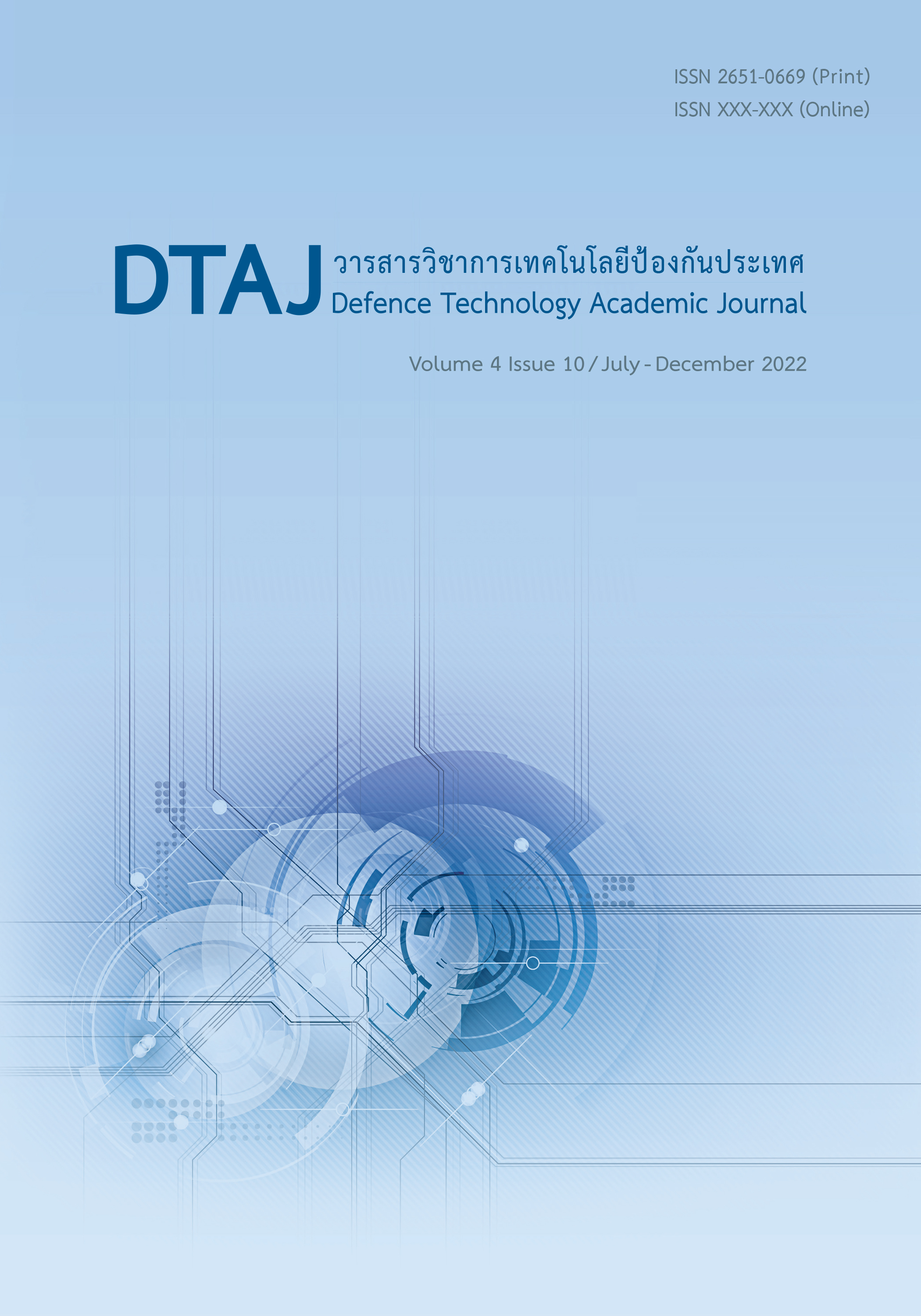The Study of the Lanchester model of air combat with the effect of range-dependent weapons’ kill probability
Main Article Content
Abstract
In modern warfare, it becomes more sophisticated for a commander to predict their battles and mission solely by their own knowledge and experience. Therefore, a tool or prediction model becomes inevitable for every force. This investigation aims to study and develop a mathematical model of aerial warfare behaviour. The study begins with the Lanchester model, and then the model is modified and extended to capture the generic behaviour of modern aerial warfare. The governing equations are the changes in the relative strengths of two forces. An air-to-air attack, sensor and situation awareness system, aircraft defence system, aircraft survivability, and aircraft deterioration are all included in the model. The effects of range-dependent weapons and their kill probabilities are also being investigated and studied. Then the case study is analysed and discussed. As a result, this study will provide an insightful understanding of modern aerial warfare, which will benefit the Royal Thai Air Force. Consequently, the model can be used for future air warfare studies and air mission planning.
Downloads
Article Details

This work is licensed under a Creative Commons Attribution-NonCommercial-NoDerivatives 4.0 International License.
Journal of TCI is licensed under a Creative Commons Attribution-NonCommercial-NoDerivatives 4.0 International (CC BY-NC-ND 4.0) licence, unless otherwise stated. Please read our Policies page for more information...
References
D. A. Novikov, “Hierarchical Models of Warfare,” Automat. Remote Control, vol. 74, no. 10, pp. 1733 - 1752, 2013.
A. M. Novikov and D. A. Novikov, “Methodology,” M.: SINTEG, 2007, p. 668.
F. W. Lanchester, Aircraft in Warfare: The Dawn of the Fourth Arm, London, Constable and Company Limited, 1916.
S. J. Deitchman, “A Lanchester Model of Guerrilla Warfare,” Oper. Res., vol. 10, no. 6, pp. 818 - 827, 1962.
G. G. Brown and A. R. Washburn, “The Fast Theater Model (FATHM),” Mil. Oper. Res., vol. 12, no. 4, pp. 33 - 45, 2007.
H. W. Jones, COSAGE User’s Manual, Volume 1-Main Report. Revision 4. ARMY CONCEPTS ANALYSIS AGENCY BETHESDA MD, 1995.
E. S. Adams and M. Mesterton-Gibbons, “Lanchester’s Attrition Models and Fights Among Social Animals,” Behav. Ecol., vol. 14, no. 5, pp. 719 - 723, 2003.
D. D. Johnson and N. J. MacKay, “Fight the Power: Lanchester’s Laws of Combat in Human Evolution,” Evol. Hum. Behav., vol. 36, no. 2, pp. 152-163, 2015.
M. A. Stanescu, N. Barriga, and M. Buro, “Using Lanchester Attrition Laws for Combat Prediction in StarCraft,” in 11th Artif. Intell. Interac. Digit. Entertainment conf., 2015.
S. Jørgensen and S. Sigué, “A Lanchester Type Dynamic Game of Advertising and Pricing,” in Games in Management Science, Springer, Cham., 2020, pp. 1 - 14.
M. Kress, “Lanchester Models for Iirregular Warfare,” Mathematics, vol. 8, no. 5, p. 737, 2020.
T. W. Lucas and T. Turkes, “Fitting Lanchester equations to the Battles of Kursk and Ardennes,” Nav. Res. Logistics, vol. 51, pp. 95 - 116, 2004.
M. Sahni and S. K. Das, “Performance of Maximum Likelihood Estimator for Fitting Lanchester Equations on Kursk Battle Data,” J. Battlef. Technol., vol. 18, no. 2, pp. 23 - 30, 2015.
N. MacKay, C. Price, and A. J. Wood, “Weight of Shell Must Tell: A Lanchestrian Reappraisal of the Battle of Jutland,” History, vol. 101, no. 4 (347), pp. 536 - 563, 2016.
P. R. Syms, “Validating Lanchester Models: The First 60 Years,” in 34th Int. Symp. Mil. Oper. Res. (ISMOR), Jul. 2017.
S. Pattanasagulloy and T. Luangwilai, “Mathematical Modelling of Air Combat by Using Lanchester Model,” The Journal of King Mongkut’s University of Technology North Bangkok, (In press).
K. Iida, Theory of Operation Research Applied for Nation Defense. Nagoya, Japan. Sankeisha, 2002.
T. Komiya, Lanchester Model, Nagoya, Japan. Sankeisha, 2019.
J. X. Liu, S. H. Xu, J. S. Gao, and Y. Q. Yuan, “An Integrated Network/firepower Operation Model Based on Lanchester Equation,” Vibroengineering PROCEDIA, vol. 17, no. 2, pp. 112 - 117, 2018.
T. Komiya and I. Koji, “Deterministic Lanchester Model of Missile Striking Battle (Part 2) Evaluation Model of Regional Air Defensecapability and Information Capability,” Scientific and engineering journal of the national defense academy, Japan, 2006.
R. E. Bach, Jr, L. Dolanský, and H. L. Stubbs, “Some Recent Contributions to the Lanchester Theory of Combat,” Oper. Res., vol. 10, no. 3, pp. 314 - 326, 1962.
S. H. Denney, A review of literature on the theory of hit and kill probabilities, 1970.
Steigers and C. William, “A Critical Analysis of a Range Dependent Probability of Kill for the NATO Seasparrow Missile System,” M.S. Thesis, Nav. Postgraduate School, Monterey, CA, USA, 1993.
G. A. Rao and S. P. Mahulikar, “New Criterion for Aircraft Susceptibility to Infrared Guided Missiles,” Aerosp. Sci. Technol., vol. 9, no. 8, pp. 701 - 712, 2005.


